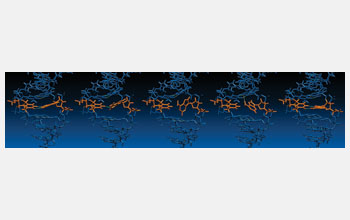Multimedia Gallery
Reshaping DNA
Researchers from the University of Michigan (U-M) and the University of California, Irvine, have found that the simple DNA double helix is capable of existing in an alternative form for 1 percent of the time.
Scientists have known for some time that the DNA molecule can bend and flex in a manner similar to a rope ladder. But throughout these gyrations its building blocks--called bases--remain paired up just the way they were originally described by James Watson and Francis Crick, who proposed the spiral staircase structure in 1953.
Using an adaptation of the nuclear magnetic resonance technology, Hashim M. Al-Hashimi, the Robert L. Kuczkowski Professor of Chemistry and professor of biophysics at U-M, and his group observed transient, alternative forms in which some steps on the stairway came apart and reassembled into stable structures other than the typical Watson-Crick base pairs.
To learn more about this research, see the U-M news story "DNA caught rock 'n rollin." [This work was supported by the National Science Foundation's Faculty Early Career Development (CAREER) Program (grants MCB 06-44278 and CHE 09-18817).] (Date of Image: October 2010)
Credit: Evgenia Nikolova, Al-Hashimi Lab, University of Michigan
Images and other media in the National Science Foundation Multimedia Gallery are available for use in print and electronic material by NSF employees, members of the media, university staff, teachers and the general public. All media in the gallery are intended for personal, educational and nonprofit/non-commercial use only.
Images credited to the National Science Foundation, a federal agency, are in the public domain. The images were created by employees of the United States Government as part of their official duties or prepared by contractors as "works for hire" for NSF. You may freely use NSF-credited images and, at your discretion, credit NSF with a "Courtesy: National Science Foundation" notation.
Additional information about general usage can be found in Conditions.
Also Available:
Download the high-resolution JPG version of the image. (2 MB)
Use your mouse to right-click (Mac users may need to Ctrl-click) the link above and choose the option that will save the file or target to your computer.

